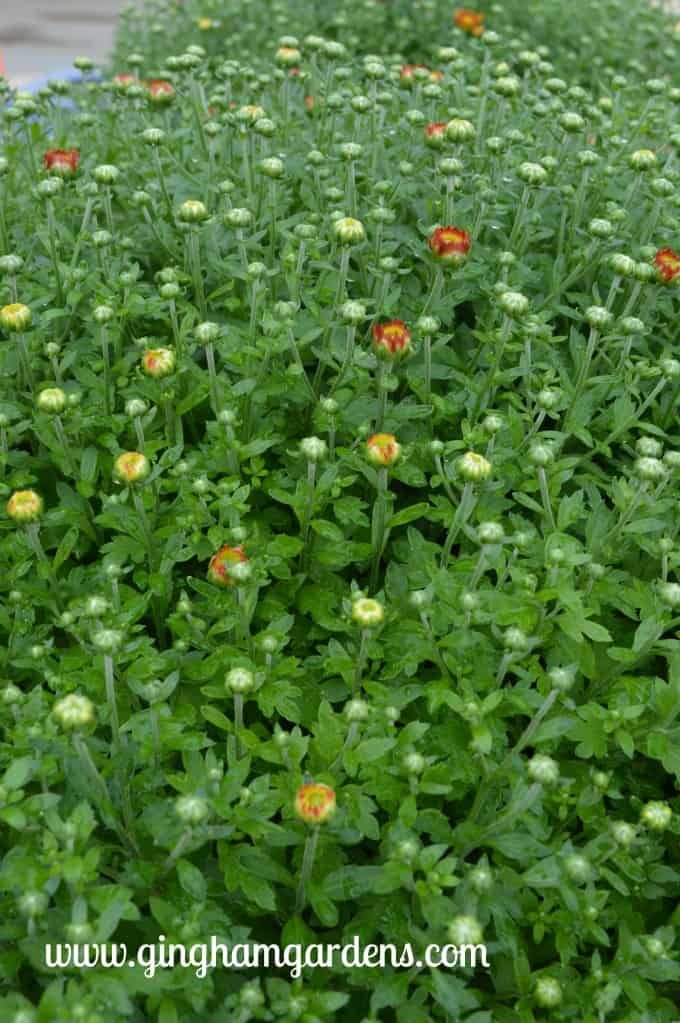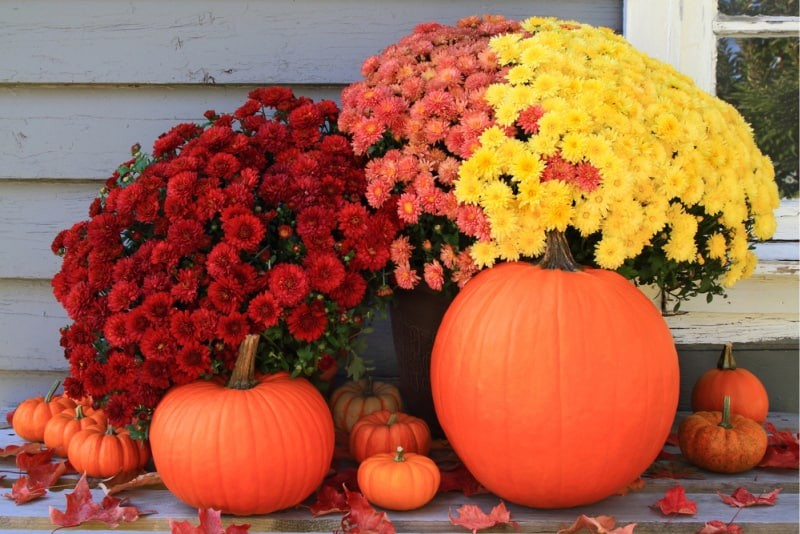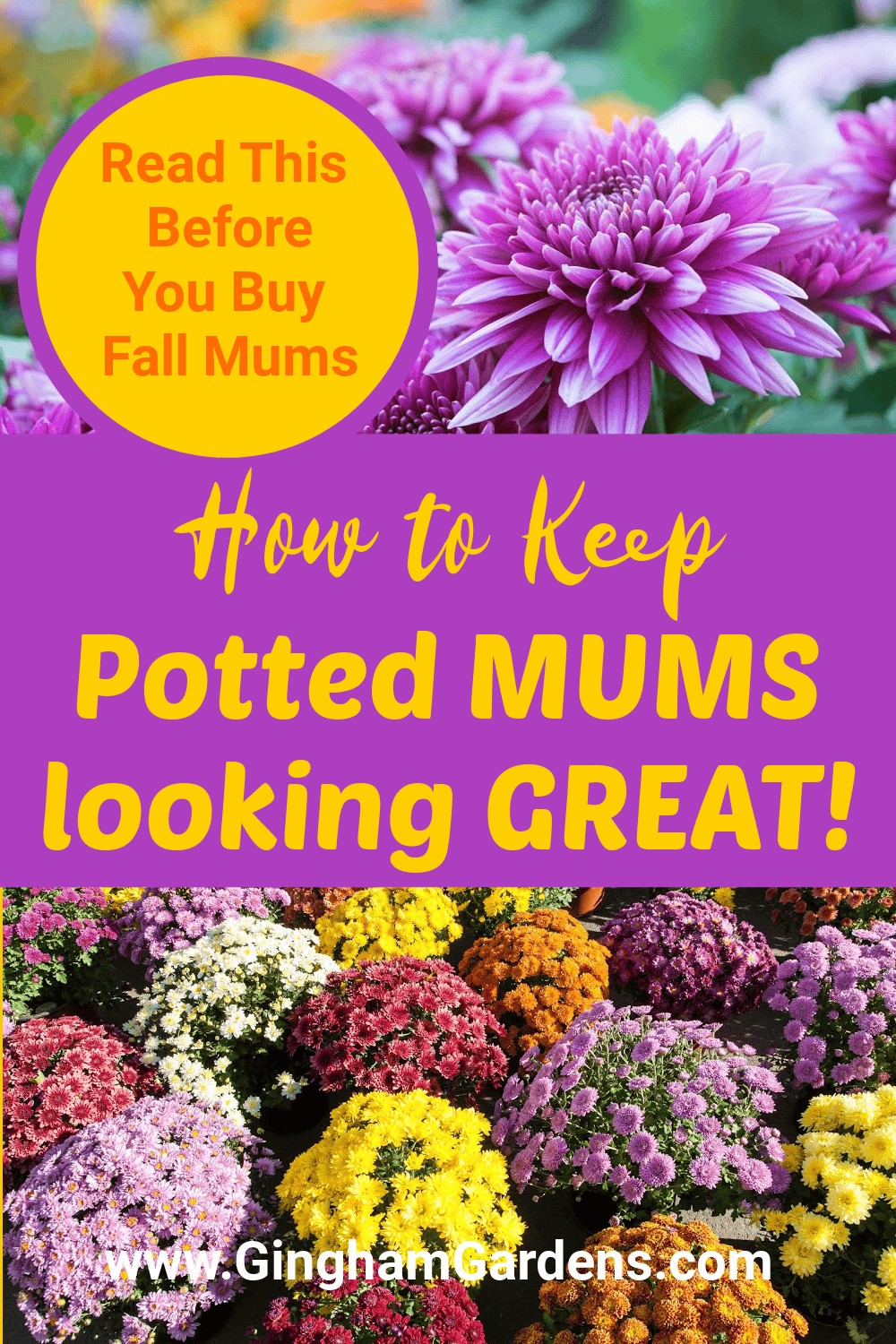Caring for potted mums can be easy with the right tips and tricks. Want to keep your chrysanthemums vibrant and blooming all season long? CARS.EDU.VN provides expert advice on chrysanthemum care, maintenance tips, and seasonal care. Let’s explore how to nurture these beautiful fall flowers, ensuring they thrive with proper watering techniques and choosing the right pot size for healthy root development.
1. Understanding Potted Mums: Basics and Types
Chrysanthemums, often called mums, are classic fall decorations. Knowing the basics helps in providing the best care. These colorful flowers bring joy and a touch of autumn to any space. They are relatively easy to care for, making them a popular choice for both novice and experienced gardeners. Whether you’re decorating your porch or adding color to your garden, understanding their needs is the first step.
- Annual vs. Perennial Mums: Annual mums are mainly for outdoor fall decorating and last only a few months. Perennial or hardy mums can be planted in the garden and return yearly. For this article, we focus on annual potted outdoor mums.
- Indoor vs. Outdoor Mums: This guide primarily covers outdoor mums, which differ in care requirements from indoor or florist mums.
1.1. The Appeal of Mums in Fall Decor
Mums are synonymous with fall, offering a burst of color when many other flowers are fading. They come in various hues, from deep reds and oranges to sunny yellows and purples. Their versatility allows them to blend seamlessly with other fall decorations like pumpkins, gourds, and colorful leaves.
The compact size of potted mums makes them ideal for decorating porches, patios, and balconies. Their cheerful appearance can instantly enhance curb appeal, creating a warm and inviting atmosphere.
1.2. Identifying Different Varieties
Understanding the different varieties of mums can help you choose the best ones for your needs. Here are some popular types:
| Variety | Characteristics | Best Use |
|---|---|---|
| Cushion Mums | Compact, mounded shape with abundant flowers | Borders, containers, mass plantings |
| Decorative Mums | Large, showy blooms with incurved petals | Cut flowers, focal points in gardens |
| Spider Mums | Unique, spidery petals that are long and tubular | Arrangements, adding texture to garden beds |
| Pompon Mums | Small, globe-shaped flowers that cover the plant | Edging, small containers, adding pops of color |
| Single/Daisy Mums | Simple, daisy-like flowers with a prominent central disc | Naturalistic gardens, attracting pollinators |
| Anemone Mums | Similar to daisy mums, but with a raised, cushion-like center | Adding interest to borders and containers |
| Quill Mums | Straight, tubular petals that give the flower a spiky appearance | Unique floral displays, adding height to gardens |
| Spoon Mums | Spoon-shaped petals that are flat at the base and rounded at the tip | Whimsical arrangements, adding texture |



1.3. Addressing Common Misconceptions
Many people believe that all mums are perennials and will automatically return the following year. While hardy mums can survive winter in the ground, annual mums are not designed to last beyond the fall season. Another misconception is that mums require little to no care. While they are relatively low-maintenance, proper watering, sunlight, and deadheading are crucial for their longevity.
2. Selecting Healthy Potted Mums for Long-Lasting Blooms
Choosing healthy mums from the start is essential for long-lasting blooms. Learning what to look for can significantly extend the life and beauty of your potted mums. This section provides practical tips on selecting the best plants.
2.1. Timing Your Purchase
- Weather Forecast: Monitor the weather forecast for your area. Mums thrive in daytime temperatures in the 60s and below.
- Seasonal Timing: In colder zones (like Minnesota, Zone 4b), it’s best to wait until mid to late September or early October before buying mums. Avoid the temptation to purchase them in late summer.
2.2. What to Look for When Shopping
- Buds Over Blooms: Choose mums with tight flower buds and plenty of new growth. These will last longer than those already in full bloom.
Image of potted mums with tightly closed buds, ideal for a longer bloom period
- Avoid Fully Bloomed Mums: While visually appealing, mums in full bloom won’t last as long.
- Foliage Check: Inspect the foliage for any signs of disease or pests. Healthy leaves are a good indicator of overall plant health.
2.3. Signs of Healthy Mums
- Vibrant Color: Healthy mums should have brightly colored foliage and buds.
- Sturdy Stems: Look for strong, upright stems that aren’t wilted or broken.
- Moist Soil: Check if the soil is adequately moist. Avoid plants with overly dry or waterlogged soil.
2.4. Where to Buy Your Mums
Consider buying your mums from local nurseries or garden centers known for their quality plants. These establishments often provide better care and advice compared to big box stores.
- Local Nurseries: Offer healthier plants and expert advice.
- Garden Centers: Provide a wide selection and knowledgeable staff.
- Farmers Markets: Freshly sourced mums directly from growers.
3. Expert Watering Techniques for Thriving Mums
Proper watering is crucial for maintaining the health and vibrancy of potted mums. Understanding their water needs and implementing effective watering techniques can make a significant difference in their longevity.
3.1. Understanding Mums’ Water Needs
- Thirsty Plants: Mums require consistent moisture and don’t tolerate dry soil well.
- Moist Soil: Aim to keep the soil consistently moist but not waterlogged.
3.2. Step-by-Step Watering Guide
- Check Soil Moisture: Stick your finger about an inch into the soil to check for moisture. If it feels dry, it’s time to water.
- Slow Soak: Water the base of the plant slowly, allowing the water to soak into the roots.
- Use a Saucer: Place a saucer under the pot to catch excess water. This helps keep the plant moist at the bottom.
- You can find suitable saucers at Amazon.
- Avoid Overwatering: If water remains in the saucer the next day, discard it to prevent root rot.
- Daily Monitoring: Check the soil moisture daily, especially during hot or windy conditions.
3.3. Common Watering Mistakes to Avoid
- Overwatering: Can lead to root rot and fungal diseases.
- Underwatering: Causes wilting, dry leaves, and reduced blooming.
- Watering the Foliage: Can promote fungal growth. Water at the base of the plant instead.
- Ignoring Drainage: Ensure the pot has adequate drainage holes.
3.4. Adjusting Watering Based on Weather
- Hot Weather: Water more frequently to prevent the soil from drying out.
- Rainy Weather: Reduce watering to avoid over saturation.
- Cool Weather: Water less frequently as the plant’s water needs decrease.
3.5. Best Time of Day to Water
- Morning Watering: Ideal, as it allows the foliage to dry before nightfall, reducing the risk of fungal diseases.
- Avoid Evening Watering: Can lead to prolonged moisture and increase the risk of fungal issues.
4. Sunlight and Location: Optimizing Growth Conditions
Mums need the right amount of sunlight to thrive. Knowing how to position your potted mums can greatly impact their health and flowering. Understanding the optimal light conditions and how to adjust them based on the weather will help your mums flourish.
4.1. Ideal Sunlight Exposure
- Full Sun: Potted fall mums prefer at least 6 hours of direct sunlight daily.
- Partial Shade: In warmer climates, protect them from the intense afternoon sun to prolong their blooming period.
4.2. Finding the Right Spot
- Outdoor Placement: Choose a location that receives ample sunlight but is sheltered from strong winds.
- Avoid Full Sun in Hot Weather: Move mums to a shadier spot if temperatures rise above the upper 70s.
4.3. Adapting to Different Climates
| Climate Type | Sunlight Needs | Additional Tips |
|---|---|---|
| Warm Climates | Partial shade to protect from intense sun | Water more frequently to prevent drying out. |
| Cool Climates | Full sun for maximum bloom | Protect from frost if temperatures drop below freezing. |
| Humid Climates | Good air circulation to prevent fungal issues | Avoid overcrowding plants to promote airflow. |
| Dry Climates | Consistent watering to maintain soil moisture | Mulch around the base of the plant to retain moisture. |
4.4. Signs of Too Much or Too Little Sunlight
- Too Much Sun: Scorched leaves, faded blooms, and dry soil.
- Too Little Sun: Leggy growth, pale leaves, and reduced blooming.
4.5. Seasonal Adjustments
- Fall: Provide full sun as temperatures cool down.
- Late Fall: Protect from frost by moving pots indoors or covering them.
5. Deadheading and Pruning: Encouraging Continuous Blooms
Deadheading and pruning are simple yet effective ways to keep your potted mums looking their best. Regularly removing spent blooms and old stems encourages new growth and maintains the plant’s tidy appearance.
5.1. What is Deadheading?
- Definition: Removing dead or faded flowers from the plant.
- Purpose: To improve the plant’s appearance and encourage new blooms.
5.2. How to Deadhead Mums
- Inspect the Plant: Look for dead or fading blooms and old stems.
- Pinch or Cut: Pinch off dead blooms with your fingers or use small pruning shears.
- Remove Old Stems: Cut back any stems that are turning brown or are no longer producing flowers.
- Tidy Appearance: Remove any fallen leaves or debris from the soil surface.
5.3. Pruning Techniques for Mums
- Pinching: Pinching back new growth encourages bushier plants with more blooms.
- Cutting Back: If the plant becomes leggy, cut it back by about one-third to promote new growth.
5.4. Tools for Deadheading and Pruning
- Fingers: For simple deadheading, pinching off spent blooms is often sufficient.
- Pruning Shears: Use small, sharp pruning shears for cutting stems and more precise deadheading.
- Gardening Gloves: Protect your hands from dirt and potential irritants.
5.5. Frequency of Deadheading
- Regularly: Deadhead mums regularly, ideally every few days, to maintain their appearance and encourage new growth.
- As Needed: Prune as needed to maintain the plant’s shape and health.
6. Soil and Fertilizing: Providing Essential Nutrients
The right soil and occasional fertilizing provide your potted mums with the nutrients they need to thrive. Choosing the correct potting mix and understanding when and how to fertilize will support healthy growth and abundant blooms.
6.1. Choosing the Right Potting Mix
- Well-Draining: Use a well-draining potting mix to prevent waterlogging.
- Nutrient-Rich: Select a mix that is rich in organic matter to provide essential nutrients.
6.2. Soil pH for Mums
- Slightly Acidic: Mums prefer a slightly acidic soil pH, ideally between 6.0 and 6.5.
- Soil Testing: Use a soil testing kit to check the pH and adjust as needed.
6.3. Fertilizing Mums for Optimal Growth
- When to Fertilize: Fertilize mums sparingly, as they are often already fertilized by the grower.
- Type of Fertilizer: Use a balanced, slow-release fertilizer or a liquid fertilizer diluted to half strength.
- How to Fertilize: Apply the fertilizer according to the package instructions, avoiding over-fertilization.
6.4. Natural Soil Amendments
- Compost: Adding compost to the potting mix provides organic matter and nutrients.
- Aged Manure: Incorporate aged manure for a slow-release source of nutrients.
6.5. Repotting for Better Growth
- Larger Pot: Repotting mums into a larger pot with fresh potting mix can help them last longer.
- Organic Matter: Add organic matter from your compost pile to the bottom of the new pot.
7. Pest and Disease Control: Protecting Your Mums
Protecting your potted mums from pests and diseases is essential for maintaining their health and appearance. Regularly inspecting your plants and implementing preventive measures can help you avoid common problems.
7.1. Common Pests Affecting Mums
- Aphids: Small, sap-sucking insects that can cause distorted growth and sticky residue.
- Spider Mites: Tiny pests that create fine webs and cause leaves to become speckled and yellowed.
- Thrips: Small, slender insects that feed on flowers and leaves, causing discoloration and distortion.
7.2. Natural Pest Control Methods
- Neem Oil: A natural insecticide that can control aphids, spider mites, and thrips.
- Insecticidal Soap: Effective against soft-bodied insects like aphids and spider mites.
- Water Spray: A strong spray of water can dislodge many pests from the plant.
7.3. Common Diseases in Mums
- Powdery Mildew: A fungal disease that causes a white, powdery coating on leaves.
- Root Rot: Caused by overwatering, leading to decay of the roots.
- Botrytis Blight: A fungal disease that causes brown spots on flowers and leaves.
7.4. Preventing Diseases
- Good Air Circulation: Ensure good air circulation around the plants to prevent fungal diseases.
- Avoid Overwatering: Water at the base of the plant and avoid overwatering to prevent root rot.
- Remove Affected Foliage: Remove and dispose of any leaves or flowers that show signs of disease.
7.5. Chemical Treatments (Use with Caution)
- Fungicides: Use fungicides to treat fungal diseases like powdery mildew and botrytis blight.
- Insecticides: Use insecticides to control severe pest infestations.
8. Extending the Bloom: Maximizing the Life of Your Mums
Extending the bloom of your potted mums involves a combination of proper care practices. By following these tips, you can enjoy their vibrant colors for as long as possible.
8.1. Consistent Care Practices
- Regular Watering: Keep the soil consistently moist but not waterlogged.
- Adequate Sunlight: Provide at least 6 hours of direct sunlight daily.
- Deadheading: Regularly remove spent blooms to encourage new growth.
- Fertilizing: Fertilize sparingly with a balanced fertilizer.
8.2. Protecting from Extreme Weather
- Hot Weather: Move mums to a shadier spot to protect them from intense sun.
- Frost Protection: Cover or move pots indoors if temperatures drop below freezing.
8.3. Repotting Techniques
- Larger Pot: Repot into a larger pot with fresh potting mix to provide more room for root growth.
- Organic Matter: Add organic matter to the soil to improve nutrient availability.
8.4. Choosing the Right Variety
- Late-Blooming Varieties: Select varieties known for their late-blooming characteristics to extend the season.
- Hardy Mums: Consider hardy mums that can withstand cooler temperatures and bloom longer.
8.5. Seasonal Considerations
- Fall Care: Focus on providing optimal sunlight and moisture.
- Late Fall Care: Protect from frost and reduce watering as temperatures drop.
9. Creative Display Ideas: Enhancing Your Fall Decor
Potted mums can be incorporated into various creative displays to enhance your fall decor. From simple porch arrangements to elaborate garden vignettes, here are some ideas to inspire you.
9.1. Porch and Patio Arrangements
- Combine with Pumpkins: Pair mums with pumpkins and gourds for a classic fall display.
- Add Fall Foliage: Incorporate colorful leaves and branches for added texture and color.
- Use Varying Heights: Create visual interest by using pots of different sizes and heights.
Image of vibrant mums and pumpkins arranged together for a fall display
9.2. Garden Vignettes
- Mass Plantings: Create a stunning display by planting multiple mums together in a garden bed.
- Container Gardens: Use mums as focal points in container gardens, surrounded by other fall plants.
- Mix Colors: Combine different colors and varieties of mums for a vibrant and dynamic display.
9.3. DIY Decor Projects
- Wreath: Create a fall wreath using mum flowers and other natural elements.
- Table Centerpiece: Use potted mums as a centerpiece for your fall table setting.
- Hanging Baskets: Plant mums in hanging baskets to add color to your porch or patio.
9.4. Complementary Plants for Fall Displays
- Ornamental Grasses: Add texture and movement to your displays with ornamental grasses.
- Kale and Cabbage: Incorporate colorful kale and cabbage for added interest.
- Pansies and Violas: These cool-season flowers provide additional color and complement mums beautifully.
9.5. Utilizing Mums in Fall Events
- Thanksgiving Decor: Use mums to decorate your Thanksgiving table and home.
- Fall Festivals: Incorporate mums into fall festival displays and events.
- Halloween Decorations: Pair mums with pumpkins and spooky decorations for a festive Halloween display.
10. Troubleshooting Common Problems: A Quick Guide
Even with the best care, you may encounter some common problems with your potted mums. This section provides a quick guide to troubleshooting these issues and getting your plants back on track.
10.1. Yellowing Leaves
- Cause: Overwatering, underwatering, nutrient deficiency, or pest infestation.
- Solution: Adjust watering, fertilize if needed, and inspect for pests.
10.2. Wilting Blooms
- Cause: Lack of water, excessive heat, or disease.
- Solution: Water thoroughly, move to a cooler location, and check for signs of disease.
10.3. Lack of Blooms
- Cause: Insufficient sunlight, improper fertilization, or failure to deadhead.
- Solution: Move to a sunnier location, fertilize with a balanced fertilizer, and deadhead regularly.
10.4. Leggy Growth
- Cause: Insufficient sunlight or lack of pruning.
- Solution: Move to a sunnier location and prune back the plant to encourage bushier growth.
10.5. Pest Infestation
- Cause: Pests feeding on the plant.
- Solution: Use natural pest control methods like neem oil or insecticidal soap.
10.6. Disease Symptoms
- Cause: Fungal or bacterial diseases.
- Solution: Remove affected foliage, improve air circulation, and use appropriate fungicides.
11. The Science Behind Mum Care: Understanding Plant Biology
Understanding the science behind mum care can help you make informed decisions and provide the best possible environment for your plants. Knowing the basics of plant biology will give you a deeper appreciation for these beautiful flowers.
11.1. Photosynthesis and Sunlight
- Process: Plants use sunlight to convert carbon dioxide and water into glucose for energy.
- Importance: Adequate sunlight is essential for photosynthesis and healthy growth.
11.2. Water Absorption and Transpiration
- Absorption: Roots absorb water and nutrients from the soil.
- Transpiration: Water evaporates from the leaves, helping to cool the plant and transport nutrients.
- Importance: Proper watering ensures that the plant has enough water for these processes.
11.3. Nutrient Uptake
- Essential Nutrients: Plants need essential nutrients like nitrogen, phosphorus, and potassium for healthy growth.
- Soil pH: The pH of the soil affects the availability of nutrients to the plant.
- Importance: Providing the right nutrients and maintaining the correct soil pH is crucial for plant health.
11.4. Flower Development
- Photoperiodism: The flowering of mums is influenced by the length of daylight.
- Temperature: Cool temperatures promote flower development.
- Importance: Understanding these factors can help you optimize conditions for blooming.
11.5. Plant Hormones
- Auxins: Promote stem elongation and cell growth.
- Cytokinins: Promote cell division and leaf growth.
- Gibberellins: Promote stem elongation and flowering.
- Importance: These hormones play a crucial role in plant growth and development.
12. Mums and the Environment: Sustainable Gardening Practices
Caring for potted mums can be done in an environmentally friendly way by adopting sustainable gardening practices. These practices not only benefit the environment but also promote healthier plants.
12.1. Choosing Eco-Friendly Products
- Organic Potting Mix: Use potting mixes made from sustainable and organic materials.
- Natural Fertilizers: Opt for natural fertilizers like compost and aged manure.
- Pest Control: Use natural pest control methods like neem oil and insecticidal soap.
12.2. Water Conservation
- Efficient Watering: Water at the base of the plant and avoid overwatering.
- Rainwater Harvesting: Collect rainwater to use for watering your plants.
- Mulching: Use mulch to retain moisture in the soil.
12.3. Composting
- Benefits: Compost improves soil health, reduces waste, and provides nutrients for your plants.
- How to Compost: Compost yard waste, kitchen scraps, and other organic materials.
12.4. Reducing Plastic Use
- Reusable Pots: Use reusable pots instead of disposable plastic containers.
- Recycle: Recycle plastic pots and containers whenever possible.
12.5. Supporting Local Nurseries
- Benefits: Buying from local nurseries supports local businesses and reduces transportation emissions.
- Knowledge: Local nurseries often provide better advice and healthier plants.
13. Expert Tips from CARS.EDU.VN: Ensuring Success
At CARS.EDU.VN, we are dedicated to providing you with expert advice and resources to ensure your success in caring for your potted mums. Here are some additional tips and insights from our team of gardening experts.
13.1. Selecting the Right Mums for Your Region
- Climate Considerations: Choose varieties that are well-suited to your local climate.
- Hardiness Zones: Consult a hardiness zone map to select mums that can withstand your region’s temperatures.
13.2. Preparing for Winter
- Overwintering Hardy Mums: If you have hardy mums, protect them from frost by covering them with mulch or moving them to a sheltered location.
- Annual Mums: Annual mums typically do not survive the winter and can be composted after they finish blooming.
13.3. Propagating Mums
- Cuttings: Propagate mums from stem cuttings in the spring.
- Division: Divide established plants in the spring or fall to create new plants.
13.4. Creating a Fall Garden Plan
- Planting Schedule: Plan your fall garden to include a variety of plants that bloom at different times.
- Companion Planting: Use companion planting to attract pollinators and repel pests.
13.5. Continuing Education
- Gardening Workshops: Attend gardening workshops to learn new techniques and tips.
- Online Resources: Utilize online resources like CARS.EDU.VN to stay informed about the latest gardening trends and best practices.
14. Frequently Asked Questions About Potted Mum Care
Here are some frequently asked questions about caring for potted mums, along with detailed answers to help you succeed.
14.1. How often should I water my potted mums?
Water thoroughly when the top inch of soil feels dry, usually every 1-2 days depending on the weather.
14.2. How much sunlight do potted mums need?
Potted mums need at least 6 hours of direct sunlight per day.
14.3. Should I fertilize my potted mums?
Fertilize sparingly with a balanced fertilizer, following the package instructions.
14.4. How do I deadhead my potted mums?
Pinch off dead or faded blooms regularly to encourage new growth.
14.5. What are common pests that affect potted mums?
Aphids, spider mites, and thrips are common pests. Use natural pest control methods to manage them.
14.6. How do I prevent diseases in my potted mums?
Ensure good air circulation, avoid overwatering, and remove any affected foliage.
14.7. Can I plant my potted mums in the ground?
Hardy mums can be planted in the ground, but annual mums typically do not survive the winter.
14.8. How do I extend the bloom of my potted mums?
Provide consistent care, protect from extreme weather, and repot into a larger pot if needed.
14.9. What kind of potting mix should I use for potted mums?
Use a well-draining potting mix that is rich in organic matter.
14.10. How do I know if I’m overwatering my potted mums?
Signs of overwatering include yellowing leaves, wilting blooms, and root rot.
15. Conclusion: Enjoying Your Beautiful Potted Mums
With the right knowledge and care, you can enjoy vibrant, long-lasting potted mums that add beauty and charm to your fall decor. By following the expert tips and techniques outlined in this guide, you can ensure that your mums thrive and bring joy to your home.
Remember, CARS.EDU.VN is here to support you with valuable insights and resources for all your gardening needs. If you are seeking more in-depth information about vehicle maintenance, repair services, or detailed car reviews, visit CARS.EDU.VN today. Our expertise extends beyond automobiles, aiming to provide a comprehensive and user-friendly experience for all our visitors.
For more information, please contact us:
Address: 456 Auto Drive, Anytown, CA 90210, United States
Whatsapp: +1 555-123-4567
Website: cars.edu.vn
Image with text overlay offering tips on caring for potted mums
